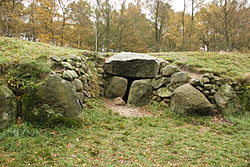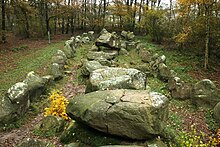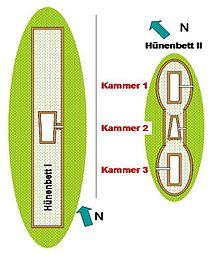Small kneading stones
| Small kneading stones officially called "small kneader stones" or the "big stones" | ||
|---|---|---|
|
Passage grave 1 with chamber |
||
|
|
||
| Coordinates | 52 ° 51 '47 " N , 8 ° 26' 12" E | |
| place | Wildeshausen , Lower Saxony , Germany | |
| Emergence | 3500 to 2800 BC Chr. | |
| Sprockhoff no. | 957-958 | |
The Kleinenknetener stones (officially Kleinenkneter stones or large stones are called) large megaliths from the Neolithic period , which close to the Wildeshauser peasantry Kleinenkneten and 3.5 km south of the Wildeshauser village lie in Wildeshausen Geest in Lower Saxony . The Kleinenknetener stones are plants of the funnel beaker culture (TBK) (3500–2800 BC). Passage tombs are a form of Neolithic megalithic systems that consist of a chamber and a structurally separated, lateral passage. The form can be found primarily in Denmark, Germany and Scandinavia as well as occasionally in France and the Netherlands. Neolithic monuments are an expression of the culture and ideology of Neolithic societies. Their origin and function are considered to be the hallmarks of social development.
The two systems were researched in 1934/1935 under the direction of the State Museum for Nature and Man (previously: State Museum for Natural History and Prehistory). Around 10,000 finds were evaluated and stored in the museum in Oldenburg. In the area of the Wildeshauser Geest Nature Park and its immediate surroundings there are another 36 facilities of a similar type. On May 14, 2009, the Megalithic Culture Road was officially inaugurated on the Kleinenknetener Steinen , at which the facility forms one of 33 stations.
Giant bed I with chamber
The restored, approximately north-south oriented complex has a complete border (the barren bed), is a passage grave and consists of 85 boulders and a covering mound that contains 1,200 m³ of earth. The stones on the narrow side, which are up to two meters high, are the highest in the enclosure. It is about 50 meters long and 7 meters wide. All the boulders installed weigh a total of 3,400 tons, which corresponds to an average stone weight of just under 4 tons.
The edging is interrupted in the middle of the eastern long side by the 1.2 meter high and 0.6 meter wide entrance, which is followed by a short unpaved corridor marked by a threshold stone. The trapezoidal chamber is framed by eleven bearing stones on which an original and two supplemented cap stones lie. The chamber, paved with rolling stones, partly with two layers, is 6.8 meters long, 2.4 meters in the north, 2.1 meters wide and 1.7 or 1.6 meters high in the south. The wall between the chamber and the border was missing and was added in the typical form. Since the pebble layer in the ceiling area on the northwest side of the chamber was not completely finished, daylight penetrates the chamber.
This giant bed was reconstructed as one should imagine it in its original state. In the course of prehistoric times the chamber was cleared out several times and used for further burials.
Hünenbett II
Is the only one in Lower Saxony and one of the very few plants in Germany in which three chambers (all passage graves ) lie within a common enclosure. In Denmark there are up to five, albeit smaller, Dysses in one bed.
The irregularity of the 34 m long border, which is constricted in the middle part, is probably due to a premature reconstruction (also observed elsewhere). Its width is up to eight meters on the outside, but only about six meters in the middle. This peculiarity gives rise to the assumption that chamber 2 was inserted last between chambers 1 and 3. The existing borders of these chambers were opened in order to use the stones when building chamber 2 or to close the border in the central area. The reason for this was probably a lack of other suitable modules in the vicinity of the systems. This is also evident from the small size and the use of inconsistent stone formats in chamber 2 and explains (to a certain extent) the trapezoidal shape of the system that was apparently last built at this location.
Chamber 1
The 7 meter long, 1.4 to 1.6 meter high and 2.0 meter wide chamber consists of 13 supporting stones. Of the once five or six cap stones, only one is left. The passage can be demonstrated through a gap on the southeast side and its two bearing stones. The threshold stone and a stone possibly serving as a lock were also found.
At the time of the excavation this burial chamber was completely untouched; The scientific significance of the finds is correspondingly great. This includes pottery shards, tools and weapons made of stone. The vessels found, including a bowl and two flasks with a collar , show considerable craftsmanship and indicate higher demands on life.
Chamber 2
The 5 meter long and between 1 and 1.5 meter wide low chamber also consists of 13 supporting stones. The five relatively small capstones are all there. The corridor approach can also be verified here through the gap on the southeast side and two pairs of bearing stones. The threshold stone was also found.
Chamber 3
The 8 meter long, 1.2 to 1.5 meter high and 1.8 meter wide chamber consists of 14 supporting stones. There are four cap stones. A fifth and possibly also a bearing stone seem to be missing in the middle of the system. The corridor is here on the southwest side and its only pair of bearing stones and the threshold stone are present.
The four chambers of this place yielded finds of ceramics (10,000 fragments), flint (axes and arrowheads) and amber as well as a copper object. Some of the shattered vessels could be reconstructed as characteristic funnel beakers or as a flask with a collar.
See also
literature
- Ute Bartelt : Own construction method - large stone graves in western Lower Saxony. In: Archeology in Germany. Volume 4/2009, pp. 26-29 ( online ).
- Anette Bußmann : Stone Age witnesses. Travel to the prehistory of northwest Germany. Isensee Verlag, Oldenburg 2009, ISBN 978-3-89995-619-1 , pp. 90-92.
- Mamoun Fansa : large stone graves between Weser and Ems. Isensee Verlag, Oldenburg 1992, ISBN 3-89442-118-5 , pp. 128-131.
- Hermann Gerdsen: The "big stones" from small putty. Two large stone graves near Wildeshausen, Oldenburg district. City of Wildeshausen, Wildeshausen 1987.
- Ernst Sprockhoff : Atlas of the megalithic tombs Germany. Part 3: Lower Saxony - Westphalia. Rudolf Habelt Verlag, Bonn 1975, ISBN 3-7749-1326-9 , pp. 138-139.
- Jürgen E. Walkowitz: The megalithic syndrome. European cult sites from the Stone Age (= contributions to the prehistory and early history of Central Europe 36). Beier & Beran, Langenweißbach 2003, ISBN 3-930036-70-3 .
- Ute Bartelt: RiesenWerk. How much work does a large stone grave make? In: Archeology in Lower Saxony , 2007, pp. 22–26 ( online ) on the construction work of Hünenbett I of the Kleinenknetener stones.
Web links
- Thomas Witzke : Megalithic graves and menhirs in Lower Saxony. Reconstructed large stone grave “Große Steine 1” (also called “Kleinenknetener Steine”), Kleinenkneten near Wildeshausen at www.strahl.org
- Pictures of the small kneader stones (stonepages.de)
- Navigator: interactive focused on the small kneading stones. Official map service of the LGLN
Individual evidence
- ↑ J. Müller in: Varia neolithica VI, 2009, p. 15.
- ↑ Working Group on Archaeological Monument Preservation of the Oldenburg Landscape: The Street of the Megalithic Culture ( Memento of the original from May 4, 2014 in the Internet Archive ) Info: The archive link was automatically inserted and not yet checked. Please check the original and archive link according to the instructions and then remove this notice.






